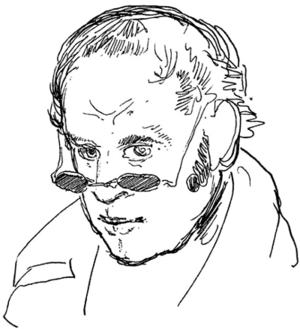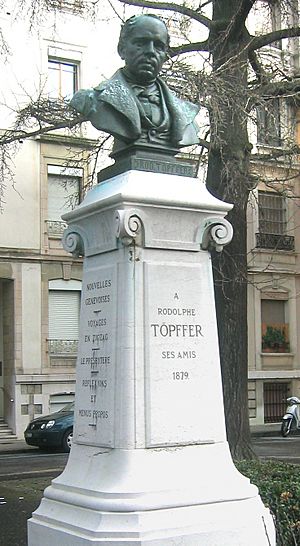Rodolphe Töpffer facts for kids
Rodolphe Töpffer (TOP-fər January 31, 1799 – June 8, 1846) was a talented Swiss teacher, writer, and artist. He is famous for his illustrated books, which he called littérature en estampes (meaning "graphic literature"). Many people believe these books were the very first European comics. Because of his work, Rodolphe Töpffer is often called the "father of comic strips" and the "first comics artist in history."
Töpffer studied in Paris. Later, he worked as a schoolteacher at a special boarding school. He would draw funny pictures, called caricatures, to entertain his students. In 1837, he published a book called Histoire de M. Vieux Bois. This book was later released in the United States in 1842 as The Adventures of Obadiah Oldbuck. Each page of his books had one to six cartoon panels with captions, much like the comics we see today. Töpffer created several more of these books and even wrote about how this new art form worked.
Contents
Rodolphe Töpffer's Life Story
Rodolphe Töpffer was born on January 31, 1799, in Geneva, which is now part of Switzerland. His father, Wolfgang-Adam Töpffer, was also a painter and sometimes drew funny pictures. Rodolphe went to school in Paris from 1819 to 1820. After that, he came back to Geneva and became a school teacher.
By 1823, he opened his own special school for boys. In 1832, he became a Professor of Literature at the University of Geneva. This means he taught about books and writing at the university.
How Töpffer Became Famous
Even though he was successful as a teacher, Rodolphe became well-known for what he did in his free time. He enjoyed painting landscapes, which are pictures of nature. His style was similar to a popular art movement called Romanticism at the time.
He also wrote short stories and drew caricatures to make his students laugh. He put these funny drawings together into books. His first book, Histoire de M. Vieux Bois (which means The Story of Mr. Wooden Head), was finished by 1827. However, it wasn't published until 1837. This book had 30 pages, and each page had one to six panels with captions.
The First American Comic Book
Histoire de M. Vieux Bois was later translated and published in the United States in 1842. It was called The Adventures of Obadiah Oldbuck. This book is considered the first American comic book.
Töpffer made his stories using a special printing method called autography. This was a type of lithography that let him draw directly onto special paper with a pen. This method made his drawings look more natural and was faster than other printing ways like engraving.
Töpffer's Published Works
Rodolphe didn't originally plan to publish his funny stories. He just made them to entertain his friends. But a famous German writer named Johann Wolfgang von Goethe saw them in 1831 and convinced Rodolphe to publish his stories. Seven of his books were eventually printed in newspapers across Europe.
Here are some of his most famous works:
- Histoire de M. Jabot (created 1831, published 1833): This story is about a middle-class man who tries to fit in with the upper class.
- Monsieur Crépin (published 1837): This book follows a father who hires many different teachers for his children, and they all turn out to be quite strange.
- Histoire de M. Vieux Bois (created 1827, published 1837): This is the story mentioned earlier, which became the first American comic book.
- Monsieur Pencil (created 1831, published 1840): This story starts with an artist losing his sketch in the wind and somehow almost causes a global war!
- Histoire d'Albert (published 1845): This book tells the adventures of a young man looking for a job. He tries many things and ends up as a journalist supporting new, radical ideas. The pictures even show people building barricades and singing.
- Histoire de Monsieur Cryptogame (published 1845): This is about a butterfly collector who goes to great lengths to find a new partner.
- Le Docteur Festus (or Voyages et aventures du Docteur Festus) (created 1831, published 1846): This story is about a scientist who travels the world trying to help people, but he doesn't realize that disaster follows him everywhere.
All seven of these books were popular in their time. They offered a funny look at society in the 1800s. Rodolphe Töpffer is seen as either the father of modern comics or at least a very important person who helped create them. He also influenced younger comic artists like Wilhelm Busch, who created Max and Moritz.
Töpffer's Ideas on Child Art
Töpffer wrote about child art and how creative children are in his book Reflections et menus propos d'un peintre genevois (1848), which was published after he died. He believed that children often showed more creativity than artists who had a lot of training. He thought that sometimes, an artist's technical skills could hide their natural creativity.
See also
 In Spanish: Rodolphe Töpffer para niños
In Spanish: Rodolphe Töpffer para niños




